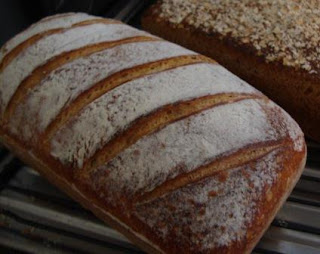You will need:
- Dried active yeast (2 tbspn) and 1/2 cup warm water & a pinch of sugar
- 1/2 cup Molasses (available from health food shops)
- 1/4 cup apple sauce
- 4 tbspn unsalted buter
- 1tbspn of treacle
- Flours: Wholemeal (1/2 cup), Stoneground Rye (2 cups), White (4 cups) If you want a 'heavier' loaf than just reduce the amount of white in exchange for rye.
- 1 cup of wheatbran (rich in vit B & folic acids)
- 2 tbspn caraway seeds
- 1/2 tsp fennel seeds
- 1 tbsp salt
- 1 tbspn cocoa powder (you can also use coffee powder)
- 1 tbspn shallots chopped finely
- For glaze: 1tbspn cornstarch + 1/2 cup water
Method:
1) Start by preparing your yeast, I used dried active. Stir dry yeast into warm water with pinch of sugar and dissolve. Let stand for 10 mins (until frothy).
 |
| 2) In a small pan heat 2 cups of water, 1/2 cup of molasses, 1/4 cup of apple sauce, 4 tbsp buter, 1 tbspn treacle & set aside. |
 |
| 3) Mix your flours together: 1/2 cup w'meal, 2 cups rye, 4 cups white & set aside. |
 |
| 4) Combine 2 cups of your mixed flour (above) with the bran, seeds, salt, cocoa powder, shallots. |
 |
| 5) Add your frothy yeast mixture and the warm molasses mixture. |
 |
| 6) Beat for about 3 minutes - until smooth |
 |
| 7) Slowly add the rest of your flour and combine |
 |
| 9) Rest your dough for about 1hr in a well greased bowl. By sprinkling flour over the top you will notice the rise as the flour will crack showing that your loaf has risen. |
































